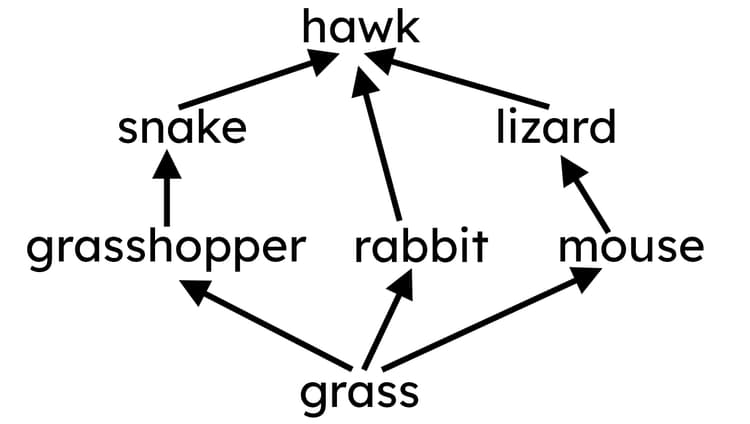Food webs
I can explain what is shown by a food web diagram and explain the effects that a change in the size of a population could have on other populations in the same community.
Food webs
I can explain what is shown by a food web diagram and explain the effects that a change in the size of a population could have on other populations in the same community.
These resources will be removed by end of Summer Term 2025.
Lesson details
Key learning points
- A community of organisms is made up of interacting populations of species.
- A food web diagram represents several interconnected food chains within a community of organisms.
- A change in the size of a population will affect other populations in the food web.
Keywords
Habitat - A habitat is the place where an organism lives. It must provide food, shelter and a place to reproduce.
Population - A group of organisms of the same type in the same place is called a population.
Community - A community is made up of all the organisms that live in the same place.
Food chain - A food chain diagram shows how food is transferred from one population of organisms to another.
Food web - A food web diagram shows how all food chains interact with each other.
Common misconception
Changes in population within a food web will only impact organisms within the same food chain.
Exemplify that disappearance of one population could affect populations in all parts of the food web (CfU questions address this also).
To help you plan your year 7 science lesson on: Food webs, download all teaching resources for free and adapt to suit your pupils' needs...
To help you plan your year 7 science lesson on: Food webs, download all teaching resources for free and adapt to suit your pupils' needs.
The starter quiz will activate and check your pupils' prior knowledge, with versions available both with and without answers in PDF format.
We use learning cycles to break down learning into key concepts or ideas linked to the learning outcome. Each learning cycle features explanations with checks for understanding and practice tasks with feedback. All of this is found in our slide decks, ready for you to download and edit. The practice tasks are also available as printable worksheets and some lessons have additional materials with extra material you might need for teaching the lesson.
The assessment exit quiz will test your pupils' understanding of the key learning points.
Our video is a tool for planning, showing how other teachers might teach the lesson, offering helpful tips, modelled explanations and inspiration for your own delivery in the classroom. Plus, you can set it as homework or revision for pupils and keep their learning on track by sharing an online pupil version of this lesson.
Explore more key stage 3 science lessons from the Ecosystems unit, dive into the full secondary science curriculum, or learn more about lesson planning.

Licence
Starter quiz
6 Questions


Producer
Primary consumer
Secondary consumer
Tertiary consumer

make their own food.
is the prey of frogs.
is a predator of water beetles.
is an apex predator.
Exit quiz
6 Questions










